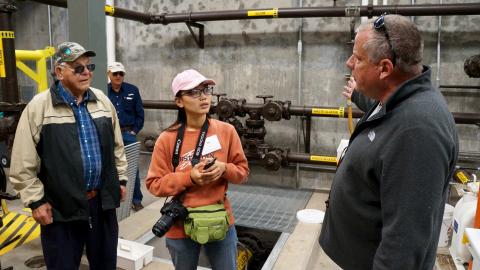By: Phuong Minh Tu Le
"Everyone has a right to use water and natural resources, and along with that right, he or she has the responsibility to preserve them."
On a sweltering day in September, we – 45 individuals from different backgrounds with ages ranging from 22 to 84 years old – first met each other in Billings, Montana. Despite the heat, the predicted cold, and the driving distances, we were there because we shared one concern: our water resources. The water current brought us together, so to speak. It then led us on a five-day tour from Montana to Wyoming, from sunshine to snowfall. While enjoying some of the magnificent views of the states, we got chances to listen and see how people consumed and protected their state's water sources.
Across Wyoming and Montana, the rain shadow effect from their abundant mountain ranges creates diverse conditions throughout the states. The driest area of Wyoming receives only 5 to 8 inches of precipitation annually (for comparison, Nebraska’s average annual precipitation is 22.9 inches). As agriculture is one of their major industries, farmers and ranchers have to irrigate their fields. Fortunately, they have adequate surface water and a substantial amount of groundwater for current and future use. However, as they are headwater states, their water quantity and quality also affect other downstream states. Due to that, regulations are put in place to ensure effective usage of the water. Researchers from various institutes are endeavoring to find the best practices for their states in the face of climate change. An interesting example is the leafcutter bee program for alfalfa field pollination in Wyoming. Farmers learned to grow their beehives for their fields with the help of the Wyoming Department of Agriculture.
Besides agricultural use, tourism, mining and extraction industries significantly affect water quality in these two states. In Montana, Big Sky County Water & Sewer District No. 363 is located in a bustling resort town. Without a permit to discharge, the facility must use treated wastewater to irrigate golf courses. They reuse their sludge – a by-product of the wastewater treatment process – by putting it into compost piles. They are facing many problems, such as managing winter’s peak demand and how to keep their water storage free of waterfowl contamination. Hence, their facility provides sufficient water supply for the area without harming its local surface water. Meanwhile, they can return nutrients to the soil by doing quality compost.
Moreover, the tour introduced us to a great Native American guide, Shane Doyle. While our bus was driving across Yellowstone National Park, Shane took us on a spiritual lesson. He taught us about how the water connects to each and all of us. Shane gave us an insight into how his tribe, the Crow, and others respect the water through stories and history. With his slow and soft voice, he led us through the sacred land where his tribe once thrived. He taught us about being grateful for what Mother Nature is giving us. The water which is running inside your body is like the water flow on rivers and streams. It gives us life.
Coming from a tropical country, I cannot imagine how little rain an area could get and how farmers can grow crops with such limitations. Five days were not enough to explore all the beautiful corners of these two states. However, it was enough for me to see how the local people shared and respected their limited water sources. The tour taught me about many aspects of the states. The issues Wyoming and Montana are facing, their changing history, the lessons they learned from managing nature, and so much more. It also allowed me to know about a variety of organizations, which are working together to improve their land.
In the end, everyone has a right to use water and natural resources, and along with that right, he or she has the responsibility to preserve them. With the changing climate, we need to be more conscious about our consumption. From what I feel from this trip, nature is a part of us, and we are parts of nature.
About the author: Phuong Minh Tu Le is a senior environmental restoration science major at the University of Nebraska-Lincoln. Originally from Vietnam, Le came to the U.S. three years ago to pursue her education.

